Defining Feature of this Generation: Specialization
The third generation saw a visible split in types of jet aircraft. While previous generations had fairly all-around aircraft, the third generation had three basic types of aircraft: Interceptors, Fighters, and Ground Attackers. These types would be used by each nation according to their doctrine and fears. The USSR built huge numbers of interceptors because of their fear of US attack. America, on the other hand, built only one fourth-gen aircraft due to upgrades made to previous second-gen planes. New countries jumped in on the jet craze, Sweden introducing their cutting-edge Viggen in this generation.
United States
McDonnell-Douglass F-4 Phantom II
The F-4 was created as a large fighter capable of both land and naval operations. It originally could carry four air-to-air missiles as its only armament. Once it was deployed to Vietnam a smart engineer realized that the Phantom could carry far more armament. It emerged from these modifications as a powerful fighter-bomber, capable of carrying the same 18,000 pound bomb-load as the WWII B-24 heavy bomber while still being able to turn around and dogfight enemy fighters. It was a well-liked aircraft, and many are still in service with smaller countries. And I think it looks pretty good.
Soviet Union
Mikoyan-Gurevich MiG-23 "Flogger"
The MiG-23 was made as a response to a need for a high-speed high performance fighter with beyond-visual-range missiles. The result was a strange looking aircraft with a variable geometry wing capable of rotating forwards for lift at low speeds and sweeping back for less drag at high speeds. In the late 70's one of these flew over the Iron Curtain after the pilot ejected, and crashed on a house in Belgium.
 |
| Wings unswept (low-speed) |
 |
| Wings swept (high-speed) |
Mikoyan-Gurevich MiG-25 "Foxbat"
The previous aircraft have all been fighters. Now it's time for a thoroughbred interceptor. The MiG-25 was built to intercept the Mach 2 capable B-58 Hustler bomber and Mach 3 capable B-70 Valkrie, and as such was extremely fast. It's still one of the fastest combat aircraft ever, 50 years after its introduction. Intercepts were usually flown at Mach 2.5 (1918 mph), and a Foxbat flying over Sinai was clocked in at Mach 3.2 (2455 mph)! By any description this aircraft was massive. It's one of the largest single-seat combat aircraft ever built. I could stand in one of the intakes without hitting my head on the top. And if I was willing to stoop a little bit I could probably walk into the exhaust duct of the engine.
 |
| Viktor Belenko getting out of his MiG-25 after overshooting the runway in Hakodate, Japan, during his defection |
Tupolev Tu-128 / Tu-28 "Fiddler"
Now, the MiG-25 was pretty great, but with its two massive after-burning engines it wasn't exactly the Prius of the skies. This empty long-range interceptor slot was filled by the Tu-28, a fairly large aircraft. It's the largest and heaviest fighter to ever enter service. Now, it's armament wasn't exceptional, but its four Bisnovat R-4 missiles would be deadly to any bomber daring enough to cross the Iron Curtain.
Sukhoi Su-15 "Flagon"
In the 60's and 70's, aviation pushed forwards at a breakneck pace. Sukhoi's Su-9 and Su-11 interceptors, built with cutting edge technology in 1960, were obsolete by 1965 as American bomber threats flew higher and faster. The result was the Su-15, an aircraft built for pure performance. While not as fast as the MiG-25 and not as long-legged as the Tu-128, it was a good in-between aircraft. This can be seen by its time in service: from 1965 to 1990. One of these jets flying at supersonic speeds at low altitude may have been the cause of the crash and death of Yuri Gagarin while he was flying an older MiG-15 jet.
Sweden
Saab 37 Viggen
Upon its introduction in 1971 the Viggen was the world's most advanced fighter (aerodynamically and electronically), a record it held for 10 years. It was designed to be a short-medium range fighter capable of taking off from improvised airstrips and even highways! It also was the first canard aircraft produced en masse. It also kept Sweden as a major player in the game of advanced jets. And the Viggen is technically a biplane. And its tail-fin can fold down for storage in cave-hangars. It's just a really cool and relatively unknown jet.
And finally, a bonus clip of a Viggen landing on a road






2 comments:
It is interesting to see how the Soviet Union pushed the US to advance its technology in terms of the military like never before.
It's fascinating to see how many advancements were made to the planes in such a short amount of time. This serves as evidence of the fear and tension between the two countries.
Post a Comment